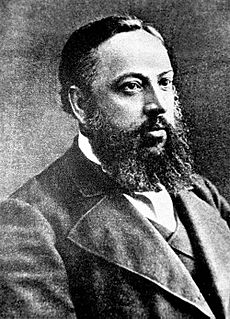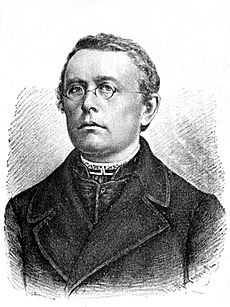National anthem of Ukraine facts for kids
| English: Ukraine's glory and freedom/will have not yet perished | |
|---|---|
| Shche ne vmerla Ukrainy i slava, i volia | |
| National anthem of | Ukraine |
| Also known as | Ukrainian: Ще не вмерла Україна English: Ukraine has not yet perished |
| Lyrics | Pavlo Chubynskyi, 1862 |
| Music | Mykhailo Verbytskyi, 1863 |
| Adopted | 15 January 1992 (music) 6 March 2003 (lyrics) |
The national anthem of Ukraine is called "Shche ne vmerla Ukrainy i slava, i volia". This means "Ukraine's glory and freedom have not yet perished". It is one of the most important symbols of the country.
The words for the anthem come from a patriotic poem. It was written in 1862 by Pavlo Chubynskyi, a famous researcher from Kyiv. A year later, in 1863, Mykhailo Verbytskyi, a Ukrainian composer and priest, wrote the music for the poem. The song was first performed in public in 1864 in Lviv.
For many years, this song was a symbol of Ukrainian independence. It was used as the national anthem by different Ukrainian states in the early 1900s. After Ukraine became independent from the Soviet Union, the song was officially adopted. The music became the anthem on January 15, 1992. The official words were added later, on March 6, 2003.
Contents
History of the Anthem
How the Anthem Began
The story of Ukraine's national anthem starts in the autumn of 1862. This is when the Ukrainian researcher Pavlo Chubynskyi wrote the words. Some historians believe he was inspired by the Polish national song "Poland Is Not Yet Lost." This Polish song was popular among people fighting for their freedom.
Chubynskyi wrote the words after hearing Serbian students sing a patriotic song in Kyiv. His poem quickly became popular among Ukrainians who loved their country. However, the authorities at the time did not like his ideas. In 1862, Chubynskyi was sent away to a far-off place called Arkhangelsk Governorate.
The poem was first officially printed in 1863 in a journal called Meta. The journal mistakenly said the poem was written by Taras Shevchenko. The song became very popular in Western Ukraine. A priest named Mykhailo Verbytskyi heard the poem and was inspired. He was a well-known composer and decided to write music for Chubynskyi's words.
The words and music were first published together in 1865. The song was first sung by a choir in public in 1864 in Lviv. One of the first recordings of the anthem was made on a gramophone record in 1916.
Early Use of the Song
The song "Shche ne vmerla Ukraina" became a state anthem in 1917. This was when the Ukrainian People's Republic was formed. However, it was not the only anthem used during that time. Other patriotic songs were also popular.
During Soviet Times
In 1922, Ukraine became part of the Soviet Union. After this, the Soviet government banned "Shche ne vmerla Ukraina." They did not want people to sing songs that showed strong Ukrainian national feelings.
Later, the Soviet republics were allowed to have their own anthems. But "Shche ne vmerla Ukraina" was still not allowed. The Soviet authorities wanted to stop any ideas of Ukrainian independence. In 1939, the song was briefly adopted as the official anthem of Carpatho-Ukraine.
After World War II, the Soviet government wanted new anthems for all its republics. They wanted songs that fit their political ideas. A new anthem for the Ukrainian Soviet Socialist Republic was created. Its words talked about Ukraine's connection with the Soviet Union. The music was chosen in 1949, and the new anthem was adopted on November 21, 1949.
After Independence
On January 15, 1992, Ukraine's parliament, the Verkhovna Rada, officially adopted "Shche ne vmerla Ukraina" as the state anthem. At first, only Mykhailo Verbytskyi's music was official. The words were not officially adopted until March 6, 2003.
On that day, the parliament passed a law about the state anthem. This law made Pavlo Chubynskyi's first verse and chorus official. However, they changed the first line slightly. Instead of "Ukraine has not yet died, as hasn't its glory and its freedom," it became "Ukraine's glory and freedom have not yet died." Most lawmakers voted for this change.
The Ukrainian anthem became very popular during the Orange Revolution protests in 2004. Its popularity grew even more during the Euromaidan protests in 2013. During Euromaidan, protesters sang the anthem every hour. This showed how important the song was to their fight for change.
A Ukrainian composer named Valentyn Sylvestrov described the anthem as "amazing." He said it feels like a "Hallelujah" and has a unique, church-like sound.
Since Euromaidan
During the Euromaidan protests in 2013, the anthem became a powerful song for the protesters. Singer Ruslana often led the crowds in singing it every hour. Many people felt the anthem helped make the protests stronger. A survey in 2014 showed that many Ukrainians felt much better about their national anthem.
After the Russian invasion of Ukraine in February 2022, the anthem gained even more attention. Many orchestras around the world performed it to show support for Ukraine. Sporting events also played the anthem to show their solidarity.
Lyrics of the Anthem
The anthem "Shche ne vmerla Ukraina" reminds Ukrainians about their fight for their own identity and independence. The music by Verbytskyi was made official in the Ukrainian Constitution on June 28, 1996.
Article 20 of the Constitution of Ukraine states:
The State Anthem of Ukraine is the national anthem set to the music of M. Verbytskyi, with words that are confirmed by the law adopted by no less than two-thirds of the constitutional composition of the Verkhovna Rada of Ukraine.
On March 6, 2003, the parliament officially adopted the words. They chose to use only the first verse and chorus from Chubynskyi's original poem. They also made a small change to the first line, as mentioned before.
Official Anthem Lyrics
| Ukrainian Original
Ще не вмерла України і слава, і воля, Душу й тіло ми положим за нашу свободу, |
English Translation
Ukraine's glory and freedom have not yet perished, Soul and body shall we lay down for our freedom, |
Full Modern Lyrics (Popular Version)
The first verse and chorus of these lyrics are the most commonly sung version of the anthem.
| Ukrainian Original
Ще не вмерла України ні слава, ні воля, Chorus: Станем, браття, в бій кривавий від Сяну до Дону, А завзяття, праця щира свого ще докаже, Chorus. |
English Translation
Ukraine's freedom has not yet perished, nor freedom, nor glory Chorus: Brothers, stand together in a bloody fight, from the Sian to the Don Our persistence and our sincere toils will be rewarded, Chorus. |
Adaptations
The song "Slava Ukraini!" (meaning "Glory to Ukraine!"), written during the 2022 Russian invasion of Ukraine, was inspired by the beginning of the Ukrainian national anthem.
See also
 In Spanish: Shche ne vmerla Ukrayina para niños
In Spanish: Shche ne vmerla Ukrayina para niños
- Shche ne vmerla Ukraina
- Anthem of the Ukrainian Soviet Socialist Republic
- Prayer for Ukraine
- Zaporizhian March
- Oi u luzi chervona kalyna
- March of Ukrainian Nationalists
- Za Ukrainu



